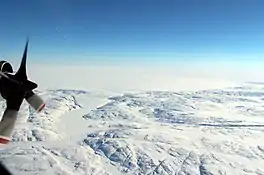Hiawatha Glacier
Hiawatha Glacier is a glacier in northwest Greenland, with its terminus in Inglefield Land.[1][2] It was mapped in 1922 by Lauge Koch, who noted that the glacier tongue extended into Lake Alida (near Foulk Fjord).[3] Hiawatha Glacier attracted attention in 2018 because of the discovery of a crater beneath the surface of the ice sheet in the area.[4] A publication noted in 1952 that Hiawatha Glacier had been retreating since 1920.[5]
| Hiawatha Glacier | |
|---|---|
 Land-terminating Hiawatha Glacier (left-center) emerging from its semicircular parent ice lobe, in NW Greenland | |
| Coordinates | 78°49′N 67°01′W |
Possible impact structure

| Hiawatha Glacier Crater | |
|---|---|
| Hiawatha Crater | |
 NASA digital elevation model with the ice sheet removed to show surface of bedrock in the region around the Hiawatha Glacier | |
| Impact crater/structure | |
| Confidence | Probable |
| Diameter | 31 kilometers (19 mi) |
| Depth | 320 meters (1,050 ft) |
| Impactor diameter | 1.5 kilometers (0.9 mi) |
| Age | 57.99 ± 0.54 Ma, Late Paleocene |
| Exposed | no |
| Drilled | no |
| Bolide type | Iron meteorite |
| Location | |
| Coordinates | 78°44′N 66°14′W |
| Country | Greenland |
| Province | Avannaata |
 Hiawatha Glacier Crater | |
| Access | none |
In November 2018, a study revealed the existence of a large (31-kilometre-wide [19 mi]) circular depression beneath Greenland's ice sheet in the Hiawatha Glacier region—up to a kilometre below the surface of the ice.[6] The bedrock within the region of this structure consists of 1.985 to 1.740 billion year old Paleoproterozoic felsic igneous rocks and paragneiss.[7]
From an interpretation of the crystalline nature of the underlying rock, together with chemical analysis of sediment washed from the crater, the impactor was argued to be a metallic asteroid with a diameter in the order of 1.5 kilometres (0.9 mi). A volume of approximately 20 cubic kilometres (4.8 cu mi) of rock would have been either vaporized or melted. Such an impact would have continued to melt ice flowing into the crater for an as-of-yet undetermined period post-impact. If an impact origin for the crater is confirmed, it would be one of the twenty-five largest known impact craters on Earth.[6]
A 2022 study using argon–argon dating combined with uranium–lead dating of shocked zircon crystals in impact melt rocks found in outwash less than 10 km downstream of the glacier yielded an age of 57.99 ± 0.54 million years ago, during the late Paleocene.[8][7] This put an end to speculation by advocates of the controversial Younger Dryas impact hypothesis.[6][9][10] that it was formed by an impact as recently as ~12,800 years ago.
References
- Dawes; et al. (2000). "Kane Basin 1999: mapping, stratigraphic studies and economic assessment of Precambrian and Lower Palaeozoic provinces in north-western Greenland". p. 11.
- "Hiawatha Gletscher: Greenland". Geographical Names. Retrieved November 15, 2018.
- Davies, William E.; Krinsley, Daniel B. (1962). "The recent regimen of the ice cap margin in North Greenland" (PDF). International Association of Scientific Hydrology, Commission of Snow and Ice. p. 124. Archived from the original (PDF) on 2021-06-25. Retrieved 2018-11-16.
- St. Fleur, Niocholas (November 14, 2018). "Ice Age Asteroid Crater Discovered Beneath Greenland Glacier - It is the first crater discovered under one of Earth's ice sheets, according to the scientists who found it". The New York Times. Retrieved November 18, 2018.
- Børge Fristrup (1952). "Die Klimaänderungen in der Arktis und ihre Bedeutung besonders für Grönland". Erdkunde. 6 (4). doi:10.3112/erdkunde.1952.04.01.
- Kjær, Kurt H.; et al. (November 2018). "A large impact crater beneath Hiawatha Glacier in northwest Greenland". Science Advances. 4 (11): eaar8173. Bibcode:2018SciA....4.8173K. doi:10.1126/sciadv.aar8173. PMC 6235527. PMID 30443592.
- Kenny, Gavin G.; Hyde, William R.; Storey, Michael; Garde, Adam A.; Whitehouse, Martin J.; Beck, Pierre; Johansson, Leif; Søndergaard, Anne Sofie; Bjørk, Anders A.; MacGregor, Joseph A.; Khan, Shfaqat A.; Mouginot, Jérémie; Johnson, Brandon C.; Silber, Elizabeth A.; Wielandt, Daniel K. P.; Kjær, Kurt H.; Larsen, Nicolaj K. (11 March 2022). "A Late Paleocene age for Greenland's Hiawatha impact structure". Science Advances. 8 (10): eabm2434. doi:10.1126/sciadv.abm2434. PMC 8906741. PMID 35263140.
- Copenhagen, University of (9 March 2022). "Giant impact crater in Greenland occurred a few million years after dinosaurs went extinct". phys.org. Archived from the original on 10 March 2022.
- Voosen P (14 November 2018). "Massive crater under Greenland's ice points to climate-altering impact in the time of humans". Sciencemag.org. Science. Archived from the original on 13 January 2019. Retrieved 13 January 2019.
- Boslough M (March–April 2019). "Crater Discovery Story Flawed by Premature Link to Speculative Impact Hypothesis". Skeptical Inquirer. 43 (2): 6–7.

